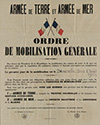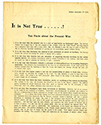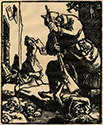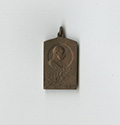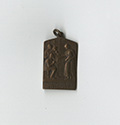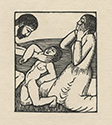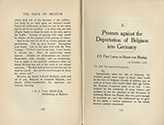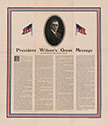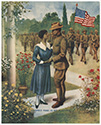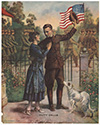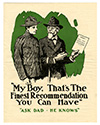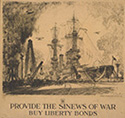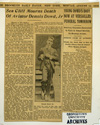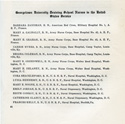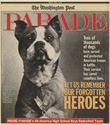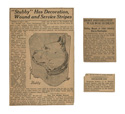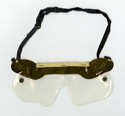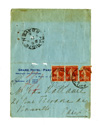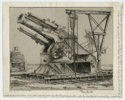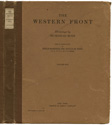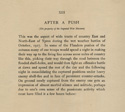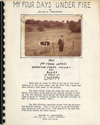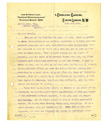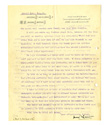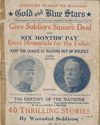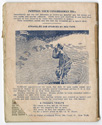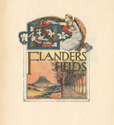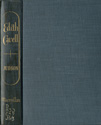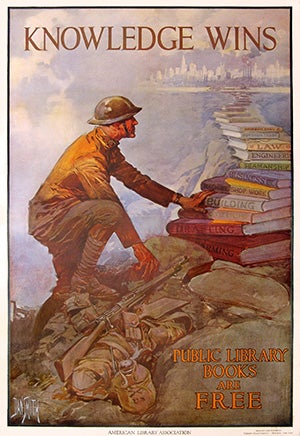 In 1914, the nations of Europe were intertwined in a network of alliances that complicated already precarious relations. Among many other issues, questions of superiority at sea, colonies, industrial production, ethnic boundaries, and personal and historical enmities created discord among the four competitive empires that ruled the European continent and the Middle East. None of these empires, the Central Powers Germany, Austria-Hungary,and Ottoman Turkey, nor the Allied Power Russia, would survive the War. When young Serbian anarchist Gavrilo Princip assassinated the Archduke Franz Ferdinand of Austria-Hungary and his wife Sophie on their visit to Sarajevo on June 28, 1914, the tipping point was reached. After failed negotiations, the Central Powers and the Allied Powers, which included France, the British Empire, Russia, and later the United States, serially declared war on one another and at the beginning of August 1914 Germany invaded neutral Belgium and Luxembourg on a failed quest to defeat France. The War had begun.
In 1914, the nations of Europe were intertwined in a network of alliances that complicated already precarious relations. Among many other issues, questions of superiority at sea, colonies, industrial production, ethnic boundaries, and personal and historical enmities created discord among the four competitive empires that ruled the European continent and the Middle East. None of these empires, the Central Powers Germany, Austria-Hungary,and Ottoman Turkey, nor the Allied Power Russia, would survive the War. When young Serbian anarchist Gavrilo Princip assassinated the Archduke Franz Ferdinand of Austria-Hungary and his wife Sophie on their visit to Sarajevo on June 28, 1914, the tipping point was reached. After failed negotiations, the Central Powers and the Allied Powers, which included France, the British Empire, Russia, and later the United States, serially declared war on one another and at the beginning of August 1914 Germany invaded neutral Belgium and Luxembourg on a failed quest to defeat France. The War had begun.
In the United States, Woodrow Wilson won his second term as president with a pledge to keep the country out of war. However, after many provocations, including the sinking of R.M.S. Lusitania and the death of 128 Americans, and Germany’s refusal to abide by international agreements restricting submarine warfare, Wilson was convinced that he had no other recourse. After bitter debate, the United States declared war on Germany on April 6, 1917. After four years of horrific combat, Germany and the Central Powers were defeated, and the guns on the Western Front fell silent on November 11, 1918, at 11 AM.
(Illustration: Dan Smith, Knowledge Wins, 1917-18, color poster. As the U.S. mobilized for war, the American Library Association recognized the need for free books, raising money to establish 32 libraries at training camps and later at the Front. ALA posters creatively promoted the value of reading: here, a soldier scales a stairway of books labeled with useful professions that he could presumably enter as soon as the War was over.)
Call to War
This wall is devoted to the onset of the War. It includes items of various belligerents and their victims – French, English, German, American, and Belgian. Posters encourage enlistment and mobilization as well as incite fury against the enemy. Books examine causes and strategies of war. Diaries, memoirs, and letters reveal what it was like to be there. Although the United States did not declare war until 1917, the propaganda campaign against the Central Powers had already been launched, so objects related to America are included here as well.
Broadside: “Ordre de Mobilisation Générale”
August 2, 1914
Ethel Crocker - Andre de Limur Collection
Box 2, folder 5
Germany and France declared war on each other on August 3, 1914. Already the previous day France issued an order of mobilization of troops, responding to Germany’s declaration against Russia on August 1. This French broadsheet calls for the armies of the land and sea to ready themselves for war and to requisition animals, cars, and necessary equipment. Colonial soldiers were included in this conscription. The exact day of the mobilization has been handwritten in ink.
Circular: “It is Not True . . . . . . !: Ten Facts about the Present War”
September 2, 1914
James Brown Scott Papers
Box 14, folder 22
Herbert Kraus (1884-1965) was a German lecturer on international law in Leipzig and a functionary in the German civil administration forced on Belgium during the War. Already in early September, a month after the War began, he mounted a defense of his country’s actions, lamenting what he called the enemies’ “attempt to conceal the truth.” To this end, he published this pamphlet, in which he made ten claims. Among them, Kraus denied that this was a war of aggression; denied that Germany violated International Law by invading Belgium’s neutrality; and denied that foreigners were ill-treated in Germany. These assertions have all proven false.
Cover letter from Herbert Kraus, University of Leipzig, accompanying the “It is Not True” circular
September 2, 1914
James Brown Scott Papers
Box 14, folder 22
Letter from Joyce Kilmer to Aline Kilmer
September 2, 1914
Joyce Kilmer Papers
Box 1, folder 11
As he penned this letter to his beloved wife Aline, Joyce Kilmer (1886-1918), best known for his poem “Trees” (1913), was on his way to the battlefields of France with the 69th Infantry Regiment. “I can get into Germany, if I wish,” he notes cryptically, “by a way I’ve just heard about privately, and I might make a lot of money – I’d be the only American newspaperman on the job.” On July 30, 1918, Kilmer was shot in the head by a sniper. He was 31. Kilmer’s son Kenton, who earned a Master’s degree from Georgetown in 1931, donated his father’s papers to the University. The papers include the Croix de Guerre medal, awarded posthumously to Kilmer by the French government.
Great Britain and the Next War
Arthur Conan Doyle
Boston: Small, Maynard & Company, 1914
Shandelle Collection
Shandelle UA647 .D76 1914
Sir Arthur Conan Doyle, creator of the Sherlock Holmes detective stories, wrote serious historical works as well. In 1913, he began Great Britain and the Next War in response to German General von Bernhardi’s 1911 book Germany and the Next War, in which the general conveyed his militarist desire to, in Conan Doyle’s words, “attack us the moment she sees a favorable opportunity.” “…[W]e should be mad” Conan Doyle stated, “if we did not take very serious notice of the warning.”
Les Prussiens Massacreurs [The Prussian Slaughterers], from the portfolio La Guerre de 1914
Auguste Lepère
ca. 1914
Woodcut on paper
Edition 17/35
Fairchild Endowment Fund purchase
1990.5.47
This rare sheet represents Plate 12 from French artist August Lepère’s portfolio of 18 original woodcuts entitled “La Guerre de 1914” (The War of 1914). Here, Lepère (1849-1918) departed from his usual picturesque, finely rendered scenes of such subjects as landscapes and cathedrals. By cutting so roughly into the woodblock, he underscored the savage violence of the Prussian slaughter of Belgian citizens. Lepère died at age sixty-nine, 11 days after the Armistice that ended the War on the Western Front.
Militantium Necessitatibus
Heinrich Kautsch
1914
Metal (bronze)
Collection of Elizabeth Prelinger
L.2017.4.1
The Austrian sculptor and medailleur Heinrich Kautsch (1859-1943) spent significant time in Paris studying sculpture and the art of making medals for famous figures and occasions. Dated December 2, 1914 (19 2/XII 14), this medal commemorates the 66th anniversary of Emperor Franz Joseph I’s succession as Emperor of Austria. On the obverse is a portrait head of Franz Joseph I (1848-1916), Emperor of Austria and King of Hungary of the Austro-Hungarian Empire. On the reverse, a mother and daughter appear to be giving alms to an elderly man; inscribed below are the words “MILITANTIUM NECESSITATIBUS,” a Latin phrase that means being justified in the case of necessity.
Slaughter of the Innocents
Eric Gill
1914
Wood engraving on paper
Fairchild Endowment Fund purchase
1987.8.6
Eric Gill (1882-1940) chose this diminutive print as the cover of a 1914 catalogue accompanying an art exhibition in England to aid Belgian refugees. After the German invasion of their neutral country in 1914, hundreds of thousands of Belgians fled to England, where they were settled, initially by a charity, and then by the British government. Gill’s simplified style and reduction of the Biblical event to three characters heightens the horror of a child being strangled in front of his mother and raises the specificity of the Belgian reference to the universality of human cruelty.
With the Allies
Richard Harding Davis
New York: Charles Scribner's Sons, 1914
Collection of Elizabeth Prelinger
L.2017.4.59
Originally published in 1914, With the Allies, by American war correspondent Richard Harding Davis (1864-1916), castigated President Woodrow Wilson for advocating American neutrality. He had arrived in Louvain, Belgium and witnessed firsthand the Germans’ destruction of the city and great library. In his introduction, dated December 1, 1914, Davis claims that if Americans could “smell the dead on the battle-fields, there would be no talk of neutrality.” It is the German “military aristocracy,” he argues, who are “military mad;” they defy “the rules of war and the rules of humanity.” In the face of these “outrages,” America’s decision to remain neutral is “unworthy and the attitude of a coward.”
The Voice of Belgium: Being the War Utterances of Cardinal Mercier
Désiré Mercier
London: Burns & Oates Ltd., 1914-1917
Collection of Elizabeth Prelinger
L.2017.4.5
Germany invaded neutral Belgium on August 4, 1914. One of the strongest voices of resistance against the German occupation and the atrocities perpetrated against the Belgian people was that of Désiré Mercier (1851-1926), the scholarly Archbishop of Mechelen (Malines) and Primate of Belgium. His pastoral letters to the Belgian Roman Catholic congregations encouraged them to help others in need and, “remain patient and persevering.” Seen here is one of many letters he sent to the Governor-General of occupied Belgium, Baron von Bissing, protesting the forced deportation of Belgian men to Germany as laborers.
Fighting France, from Dunkerque to Belfort
Edith Wharton
New York: Charles Scribner's Sons, 1915
General Collection
92A553
In 1915, American novelist Edith Wharton published a compilation of her articles for Scribner’s Magazine describing her service in France during the War. At the time the War broke out in 1914, she was living in Paris. There she created a variety of charities that included caring for Belgian refugees from the German invasion. One of the most insightful and disturbing observations in this book reads: “It is one of the most detestable things about war that everything connected with it, except the death and ruin that result, is … so visually stimulating and absorbing.”
"I Accuse!" ("J'Accuse!") by a German
Richard Grelling, translated by Alexander Gray
New York: George H. Doran Company, 1915
Russell J. Bowen Collection
Off-Campus Shelving - Request in Special Collections MI-12906
Originally published in Switzerland by German pacifist Richard Grelling (1853-1929), I Accuse! borrowed its famed title from French author Émile Zola’s eponymous open letter of 1898 defending the military officer Alfred Dreyfus against a false charge of treason. Banned in Grelling’s native land but translated into many languages, the book excoriates Germany for perpetrating a long-planned war and thereby “unchain[ing] the most fearful disaster which has ever fallen upon our globe, and which is inflicting on [the] Fatherland, whether victorious or defeated, wounds which will be incurable for generations to come…” Even the translation was censored and blank lines scattered throughout the volume betray how much text was removed.
France at War
Rudyard Kipling
London: Macmillan, 1915
Shandelle Collection
Shandelle 1916 .K521
British author of The Jungle Book and “The Man Who Would Be King,” among many other novels and short stories, Rudyard Kipling (1865-1936) won the Nobel Prize in Literature in 1907, at the age of 42. Solicited by the government in 1914, Kipling produced wrathful propaganda against Germany and in particular against that country’s illegal invasion of Belgium. In 1915 Kipling made a trip to the Western Front, recording his impressions in France at War. His son John was killed on the battlefield at Loos in northern France ten days after publication.
Le Miroir 3/5/1916
Paris, 3/5/1916
Commercial/offset printing on paper
Collection of Elizabeth Prelinger
L.2017.4.51
Le Miroir [The Mirror] was a weekly French magazine founded in 1910 that recorded current events through photography. It was the most explicit and violent magazine of the War, plunging readers directly into the action. The editors solicited photographs from amateurs in exchange for payment and after 1914 focused almost exclusively on the War. Its program was bold; despite some retouching of the images, pictures revealed corpses, hangings, and other horrors. This set of images reveals the destruction by the Germans of San Apollinaire in Classe, Ravenna, one of the great Italian basilicas.
Barlow Diary II, entries written from Berlin, Germany
ca. May to July 1916
Ernesta Drinker Barlow Papers
Box 2, folder 4
At the time that Philadelphia socialite Aimee Ernesta Drinker Barlow (1892-1981) wrote these diary entries she was married to William C. Bullitt (1891-1967), a journalist and diplomat. After their wedding in 1916 they traveled to Europe in the midst of the War. In Berlin, Barlow kept careful diaries, in which she mentions everything from lunch with American Ambassador James W. Gerard, to butter shortages, to tea made from “dried strawberry leaves.” She also wrote at length about her disillusionment with “French chivalry,” describing “cattle cars” that conveyed German prisoners of war, along with women and children, to “concentration camps” in France.
Broadside: “President Wilson’s Great Message”
April 2, 1917
Francis A. Barnum, SJ Papers
Box 13, folder 1
On April 2, 1917, President Wilson convened a special session of the 65th Congress because “there are serious, very serious, choices of policy to be made…” His speech that day, requesting Congress to send troops into the war against Germany, is reproduced here in this commemorative broadsheet. “It is a fearful thing,” Wilson observed, “to lead this great peaceful people into war, into the most terrible and disastrous of all wars, civilization itself seeming to be in the balance.” Four days later, on April 6, Congress finally voted to proceed.
“I summon you to the comradeship,” - Pres. Wilson
Leo Mielziner
1918
Lithograph on paper
Facsimile of a poster in the Art Collection
Gift of Warren Wilson and David Van Buskirk
1997.44.118.1
The government charter of the American Red Cross mandated that it support the military. President Wilson enthusiastically endorsed the relief efforts of the Red Cross to countries and peoples devastated by the War after 1914. Through the Red Cross, and its local chapters in Europe, medical supplies and personnel were made available to troops and civilian populations. Posters encouraged women to knit mittens, roll bandages, and perform other charitable activities on the home front. Here, a dignified portrait of Wilson sincerely encourages the public to contribute to the Red Cross.
Broadsheet: “Cheer Up! Let The Hun Have the Grouch. He Has Good Reason For It”
ca. 1917
Francis A. Barnum, SJ Papers
Box 13, folder 1
Colored Man is No Slacker
E. G. Renesch
1918
Commercial/offset printing on paper
Fairchild Endowment Fund purchase
1111.1.6286
The Chicago illustrator E. G. Renesch (1879- after 1942) published chromolithographs that encouraged pride in America and enlistment in the army on the part of Black Americans. Much of his work reflects The Great Migration to Chicago and other northern and western cities starting in 1916, as Black citizens left the South seeking greater social and economic opportunities. Ultimately some 350,000 African-American soldiers served in segregated units, though in menial jobs rather than in combat. At this time, the word “slacker” meant “draft dodger,” as well as “shirker,” lending another layer of meaning to this brightly hued image, in which a dignified young Black soldier takes leave of his well-dressed wife or sweetheart as he prepares to join the African-American regiment marching by, flag raised high.
Duty Calls
E. G. Renesch
1917
Commercial/offset printing on paper
Fairchild Endowment Fund purchase
1111.1.6287
The poster Duty Calls could serve as a pendant to Colored Man is No Slacker. The scene yet again depicts a young soldier parting from his wife; this time they are Caucasians. Unlike the African-American woman, this one wears a conspicuous ring on her deliberately displayed hand. An elegant dog tugs at the soldier’s breeches.
Fight or Buy Bonds
Howard Chandler Christy
1917
Lithograph on linen-backed paper
Facsimile of a poster in the Art Collection
Gift of Warren Wilson and David Van Buskirk
1997.44.252
Illustrator Howard Chandler Christy (1872-1952) was best known for his creation of the “Christy girl,” sex symbol of the Jazz Age. The Christy girl also sold men on the War through her suggestive poses. Even the allegorical figure of Columbia, stately symbol of the nation since the 1730s, has been transformed into a sensual nymph. In his 1919 book Art and the Great War, Albert Eugene Gallatin, then chairman of the Committee on Exhibitions of the government’s Division of Pictorial Publicity, opined that Christy’s images were “not posters at all,” but merely “poorly drawn sketches.” Nevertheless, they have become icons of WWI propaganda.
I WANT YOU FOR U.S. ARMY
James Montgomery Flagg
1917
Lithograph on linen-backed paper
Facsimile of a poster in the Art Collection
Gift of Warren Wilson and David Van Buskirk
1997.44.240
Of the 2,500 some posters created by the U.S. in WWI, James Montgomery Flagg’s dramatic call for men to enlist in the U.S. Army surely remains the most famous. Based on a British poster, the artist’s image depicts Uncle Sam, the national symbol of the American government, clad in a kind of flag costume. Using a patriotic palette of colors, Flagg further heightened the urgency of the demand by drastically foreshortening the right arm, such that Uncle Sam’s finger points directly at the individual viewer’s face. Flagg was a member of the Society of Illustrators, working through the national Division of Pictorial Publicity of the Committee on Public Information, which was tasked with creating propaganda for the War.
My Four Years in Germany
James W. Gerard
New York: George H. Doran Co., 1917
Circulating Collection
D515.G4 1917b
Lawyer James W. Gerard (1867-1951) served as U.S. ambassador to Germany from October 1913 to February 1917, when he departed Berlin at the request of the German imperial government after diplomatic relations with the United States were severed. His book combines anecdotes such as the challenge of finding a suitable ambassadorial residence and meeting the Kaiser at court, with admonitions about Germany’s “brutal autocracy.” Warner Brothers made a silent film of the book in 1918 with Gerard’s participation; the advertising poster lauds the successful product as the “Screen Classic [that] has put Pep in Our Patriotism.” This piece of propaganda, about two hours long, is one of the first films, if not the first, to combine acting with original footage. It is available on YouTube.
The National Draft Bowl
Charles R. Morris
[Washington, D.C.?], 1917
General Collection
80A389
A process for selective service was instituted on May 18, 1917 to create an army to participate in the war America had avoided for almost three years. The National Draft Bowl was quite literally a bowl, filled with capsules with paper numbers inside them that had been assigned to registered men across the country. In addition to describing in minute detail the process by which the blindfolded officers stirred the bowl’s contents and extracted and recorded the capsules, the pamphlet displays an original number.
Poster: “Universal Military Training”
ca. 1917
Francis A. Barnum, SJ Papers
Box 13, folder 1
George Earle Chamberlain, Governor of Oregon and later U.S. Senator, urgently advocated the creation of the selective service as the U.S. prepared to enter the War. This broadsheet presents strong arguments for rejecting volunteerism in favor of establishing the draft, as well as for preparing young men for military engagement through training camps. The sheet provides templates for writing or telegraphing one’s “Congressman and both your Senators at once” in favor of the “Chamberlain Bill.”
Teufel Hunden - German Nickname for U.S. Marines
Charles Buckles Falls
1917
Lithograph on paper
Facsimile of a poster in the Art Collection
Gift of Warren Wilson and David Van Buskirk
1997.44.286
An advertisement for a Marine Corps recruiting station, Falls’s poster depicts a bulldog, mascot of the Marine Corps, sporting a marine helmet and chasing a terrified dachshund wearing a Prussian spiked helmet, or Pickelhaube. “Teufel Hunden” literally means “Devil Dogs” (sometimes, “hounds of hell”), supposedly the German nickname for the U.S. Marines. Recent scholarship questions whether the nickname was really adopted by the Germans or whether it was indeed an American war reporter who coined the evocative moniker. Falls contributed to the massive amount of propaganda during the War by way of the Society of Illustrators, an organization founded in 1901. Members produced posters and eight of them traveled to France to make direct sketches from the field.
The World War: Its Relation to the Eastern Question and Armageddon
Arthur Grosvenor Daniells
Washington, D.C.: The Review and Herald Publishing, 1917
Collection of Elizabeth Prelinger
L.2017.4.2
Arthur Grosvenor Daniells (1858-1935), author of this tract that examines the “great war of Armageddon,” was an American Seventh-Day Adventist. Here he branded the World War, “The Cross on which the Peace of the World has been Crucified.” The editors of the official Seventh-Day Adventist press that printed the tract called upon the “Word of the Living God” for sustenance in wartime. A year before the end of the War they accurately predicted that, “the curtain will go down on a world that will never reappear. That war will close an age…”
Go Over the Top With U.S. Marines
John A. Coughlin
ca. 1917-1918
Lithograph on paper
Facsimile of a poster in the Art Collection
Gift of Warren Wilson and David Van Buskirk
1997.44.183.1
A dramatic enlistment plug for the Marines, Go Over the Top depicts a square-jawed young American hurtling over the parapet of a trench while his comrades join him, carrying rifles with bayonets and the American flag. Going “over the top” meant leaving the shelter of the trenches and storming across No Man’s Land toward the enemy. Here, the marine hefts a Lewis M1017, a 28-pound machine gun, gas-operated, that fired 500 to 600 rounds per minute at 2,440 feet per second. Invented in 1911 by West Point graduate Colonel Isaac Newton Lewis (1851-1931), the gun exemplified the modern mechanization of WWI.
“Good-Bye, Dad, I’m Off To Fight For Old Glory, You Buy U.S. Gov’t Bonds”
Lawren S. Harris
ca. 1917-1918
Lithograph on paper
Facsimile of a poster in the Art Collection
Gift of Warren Wilson and David Van Buskirk
1997.44.136.1
Lawren S. Harris (1885-1970) was a member of the modernist Canadian “Group of Seven,” which became known for spectacular scenes of that country’s landscape. Harris positioned this soldier against a peaceful countryside of rolling hills. As he takes leave of his father the recruit urges him to buy the U.S. bonds that financed the War. The Third Liberty Loan was open from April 6, the anniversary of America’s declaration of war, to May 4, 1918. As part of the United Kingdom, Canada had joined the War in 1914; in 1916 Harris taught small arms techniques at a Canadian army camp.
Beat Back the HUN with Liberty Bonds
Frederick Strothmann
1918
Lithograph on paper
Facsimile of a poster in the Art Collection
Gift of Warren Wilson and David Van Buskirk
1997.44.1.1
Frederick Strothmann’s propaganda poster typifies the genre’s most effective visual language: bold, simplified imagery and clear, expressive typefaces. By using the derogatory term “Hun” for German, Strothmann evoked the barbarian leader Attila, scourge of the 5th-century Roman Empire. The U.S. Department of the Treasury sponsored these fear-mongering fundraising posters with the aim of selling bonds for the series of so-called Liberty Loans that financed the War. This example advertises the fourth Liberty Loan drive of 1918.
Broadsheet: “My Boy, That's the Finest Recommendation You Can Have/Ask Dad - He Knows”
ca. 1918
Francis A. Barnum, SJ Papers
Box 13, folder 1
Face to Face with Kaiserism
James W. Gerard
New York: George H. Doran Company, 1918
Collection of Elizabeth Prelinger
L.2017.4.4
One may view this book as a kind of sequel to My Four Years in Germany (1917). Its tone is far harsher, however, as Gerard exposes the Kaiser’s militarism and desire for world domination. Although the War had not yet come to a close, Gerard, by his own admission a Cassandra – “the prophetess fated to be right, but never believed” - already presciently foresaw a “great readjustment” in the “social structure of the world.” The remarkable volume exhibited here is unique. The owner, Lena Morse Wilson of San Francisco, annotated the text with remarks and quotes taken from other sources, and pasted in photographs and articles from newspapers and illustrated magazines. Wilson clipped many articles ridiculing the Ex-Kaiser, exiled since 1918 to Doorn, Holland.
Provide the Sinews of War
Joseph Pennell
1918
Lithograph on paper laid on board
Facsimile of a poster in the Art Collection
Gift of Warren Wilson and David Van Buskirk
1997.44.8
American author, artist, and illustrator Joseph Pennell (1857- 1926) made some of the best-known posters of the War. Designed for the launch of the Third Liberty Loan, this image celebrates naval and aerial power, depicting a shipyard with a battleship under construction and planes buzzing around it. Pennell drew the scene directly at the New York docks, accounting for its immediacy and drama.
Georgetown and the War
Texts by Lynn Conway, University Archivist
Colleges and universities across America typically responded enthusiastically and responsibly to the Government’s call for military training and registering for the newly formed Selective Service. As early as 1916 the Reserve Officer Training Corps (ROTC) was established and Georgetown figured among the educational institutions that supplemented the standard academic program with military courses. The documents exhibited here illustrate the impressive range of activities, personalities, and achievements of Georgetown men, in addition to the College’s famous mascot Stubby the dog, himself an iconic American war hero.
Lt. Dennis P. Dowd, Jr. (C'08)
ca. 1915
Photograph
University Archives Photographic Collection
Dennis Dowd, Jr., of Sea Cliff, Long Island, was the first American to travel to Europe to enlist after the outbreak of the War. After graduating from The College in 1908 and earning a law degree from Columbia University, he sailed for France six days after War was declared and joined the French Foreign Legion. Later he trained as an aviator. Dowd’s plane crashed near Paris on August 11, 1916. He is buried in the Old Communal Cemetery in Saint-Germain-en-Laye outside of Paris.
“Sea Cliff Mourns the death of Aviator Dennis Dowd, Jr. / Young Dowd’s Body Now at Versailles; Funeral Tomorrow.”
The Brooklyn Daily Eagle
August 14, 1916
University Archives Alumni Files
Although Dennis Dowd, Jr. fought in the early battles of the War, lived for over a year in the trenches, and was wounded, the plane crash in which he was killed was actually an accident that occurred during a training exercise.
Membership Cards for Reserve Officers’ Training Corps at Georgetown
April 1917
University Archives Military Files
Box 2, folder 1
When the government of the United States declared war on Germany on April 6, 1917, a unit of the Reserve Officers’ Training Corps was quickly formed on campus. This unit trained and prepared officers well before the complete mobilization of American colleges under the Students’ Army Training Corps in the summer of 1918.
Response envelopes for survey of Georgetown men serving in the War, conducted by the Georgetown College Journal
October-December 1917
University Archives Military Files
Box 2, folder 1
In October 1917, the Georgetown College Journal began a register of University men (faculty and students) who were serving in the military. They sent out a survey, including these response envelopes, and results were printed in the Journal.
Program from the Solemn Blessing of the Service Flag to be Raised in Honor of the Seven Hundred and Sixty-One Sons of Georgetown Who Have Devoted Themselves to the Cause of their Country
December 9, 1917
University Archives Military Files
Box 2, folder 2
Register of Georgetown Men Serving
Georgetown College Journal
December 1917
By December 16, 1918, 2378 Georgetown men had enlisted.
“Georgetown University Training School Nurses in the United States Service”
Georgetown College Journal
October 1918
Like their male counterparts, women graduates of Georgetown were involved in the War effort. The nurses listed earned diplomas in Nursing between 1911 and 1916. At the time of the War, the School of Nursing was the only school at Georgetown in which women could enroll. Above the list is a transcription of a letter of commendation for Georgetown student Sub-Flight Lieutenant David Leland “Barney” Bawlf, the first Georgetown alumnus to be killed in action, a “most daring and excellent officer.”
“One member in a family is not enough.” Red Cross Christmas Roll Call announcement
Georgetown College Journal
November 1918
A few weeks after the German invasion of Belgium, the Red Cross organization sent a relief ship to Europe with surgeons, nurses, and medical supplies. The towns of Belgium were in ruins and the roads swarmed with refugees. Lack of adequate funding from the U.S. government impeded aid to millions of victims. The Red Cross launched appeals to the American, and later European, public, raising huge amounts of money. A donation equaled membership in the organization. Many posters promoted these drives. Here, in a simple black and white print advertisement in the Georgetown College Journal, the daughter of a proud family has enlisted as a nurse; now the others must contribute in their own ways.
Letter written by Lieutenant W.G. McNulty (C’14) from “Somewhere in France,” October 12, 1917
Georgetown College Journal
January 1918
In addition to providing lists of alumni serving in the armed forces, the Georgetown College Journal also published transcriptions of their letters. These describe, sometimes in rich detail, their lives in the services. Unfortunately, the original letters do not survive in the University Archives. Lieutenant McNulty writes: “The regulations on uniforms are very strict over here… The food is very good considering war times… There is a great deal of interest in the World Series, and I’m backing the Sox to the tune of 100 francs, and willing to bet more.”*
* That bet would have been a good one. In the 1917 World Series, the Chicago White Sox beat the New York Giants four games to two.
First Service Flag on Healy Hall
Georgetown College Journal
January 1918
The flag pictured in the photograph was made by the senior class of the Georgetown Visitation Academy. It was blessed and raised on December 9, 1917, in honor of all Georgetown alumni who were serving in the armed forces. Thomas R. Marshall, Vice President of the United States, spoke at the ceremony, saying that he had come gladly to “congratulate this ancient and honorable institution upon its long and historic course of loyalty, patriotism and devotion for the cause of the Republic.” The poem printed below the photograph sends prayers to the soldiers.
Sub-Flight Lieutenant David Leland “Barney” Bawlf. First Georgetown alumnus to be killed in action, April 21, 1918
Undated photograph
University Archives Photographic Collection
Born in Winnipeg, Canada, Sub-Flight Lieutenant Bawlf was a student at Georgetown when the War broke out. As an aviator for the Royal Naval Air Service, he died during an aerial encounter on April 21, 1918, the first Georgetown serviceman to die in action rather than from accident or sickness.
Combat practice on campus
1918
Photograph
University Archives Photographic Collection
This photograph shows students in practice on Healy Lawn. After the inauguration of the Students’ Army Training Corps program, there were around 800 military personnel (officers and candidates) on campus. Upon completion of three months of training, candidates were transferred to regular military camps for final training as commissioned officers.
Drilling in Ryan Gymnasium
1918
Photograph
University Archives Photographic Collection
The entire student body shifted to military status and was assigned to follow a combined military and academic program specified by the War and Navy Department. Students under 18 years of age were instructed separately as a civilian unit. Here, students drill in the Ryan Gym, which opened in October 1906. It is now incorporated into the Davis Performing Arts Center.
Profile of John S. Easby-Smith
Ye Domesday Booke
1918
John S. Easby-Smith, holder of multiple degrees from Georgetown, Professor of Law, and Lieutenant Colonel in the Judge Advocate General’s Corps, was one of the authors of the 1917 Selective Service Act, which required all males aged 21 to 30 to register for military service. This age range was later changed to 18 to 45 and, by the end of the War, some 24 million men had registered and some 2.8 million had been drafted. The yearbook notes that Lieutenant Colonel Easby-Smith was the first professor in the history of the University to lecture in uniform.
Transcription of a letter from France written by former Law student, John J. “Jack” McCarthy
Ye Domesday Booke
1918
Broken lines [-------] indicate where portions of the original letter were removed by censors: “But I cannot say I am alone here for indeed it seems that France is full of Georgetown men. Many of them I did not know when I was in school…but when we meet over here it is like the meeting of long lost brothers.”
Jack McCarthy returned to the University after the War, graduating from the Law School in 1920 along with William C. “Billy” McCabe and Thomas “Tom” Carroll whom he mentions in his letter. Tom Carroll went on to work as a test pilot.
Planting of memorial trees
June 16, 1919
Photograph
University Archives Photographic Collection: Oversize
As part of its commencement ceremonies in 1919, Georgetown dedicated memorial poplar trees to 54 alumni who had lost their lives in the service of their country during the War. The trees, Lombardy poplars, were planted by the senior class close to the area now occupied by the Harbin Field/Multi Sport Facility. By the middle of August, 1919, fifty-three trees were thriving but one had died. Before the tree could be replaced, however, the University learned that one of the alumni who had been reported killed in action was alive and that only fifty-three memorial trees were, in fact, needed. In 1927, the trees were moved to a spot behind what is now the White-Gravenor building. None survive today.
Program for the Planting of Memorial Trees and Unfurling of Gold Star Service Flag
June 16, 1919
University Archives Commencement Files
Box 4, folder 1
Raymond H. Reiss (C’19), for whom the Reiss Science Building is named, gave the opening address at the planting ceremony: “We, the graduating class of 1919, are assembled here today to give fitting testimony to the memory of fifty-four of Georgetown’s sons. Many are the valiant deeds that Georgetown’s sons have performed. These fifty-four have, however, eclipsed all the others in their devotion to God, their country, their Alma Mater. They have performed deeds which no material tribute can adequately appreciate; in memory alone, that spiritual organ, can we find any proportional thanksgiving. It is in the memory of these fifty-four men, Georgetown patriots, who made the supreme sacrifice, that these trees are reverently dedicated.”
War Department certificate recognizing Georgetown University for operating a Students’ Army Training Corps program
1921
University Archives Military Files
Box 3, folder 1
“This is to certify that Georgetown University in a spirit of patriotism and of devotion to country rendered efficient and loyal service in connection with The World War through the establishment and operation…of a unit of The Students’ Army Training Corps.”
Dr. Ernest P. Magruder
Undated photograph
University Archives Photographic Collection
Dr. Ernest P. Magruder, a faculty member at the Medical Center as well as a former Georgetown student, was one of the first doctors to travel to Serbia in 1914 in response to a Red Cross appeal. He died in Gevegelia, Serbia, on April 8, 1915, one of five American medical personnel who succumbed to typhus when an epidemic swept the region. His body, initially interred in Belgrade, came home to be buried in his family’s plot in Prince George’s County, Maryland, in 1920.
“Serbian Govt. Honors Dr. Ernest Magruder.”
The Hoya
January 27, 1927
Dr. Magruder was posthumously awarded the Cross of St. Sava by the Serbian Government in recognition of valuable services rendered.
Stubby, Georgetown mascot from 1922-1924 and decorated World War I Hero. Pictured on the cover of The Washington Post Parade Magazine.
April 1, 2001
University Archives Varia Additions
Box 1, folder 4
After World War I, many veterans came to Georgetown, among them a dog named Stubby, who was said to represent the breed of Boston bull terrier in a general way. Stubby had been adopted by the 102nd Infantry while it was training at Yale and, when his unit deployed to France, he went along, smuggled on the troop ship S.S. Minnesota. On February 5, 1918 Stubby was in the trenches, fitted with his own gas mask. General John J. Pershing awarded the hero a gold medal in 1921, and the terrier became a life member of the American Red Cross and the YMCA. Stubby arrived at Georgetown the following year with his companion J. Robert Conroy, a Law student, and became the mascot for the football team. Between halves, Stubby would nudge a football around the field, much to the delight of the crowd.
When he died in 1926, The Hoya ran an obituary which read in part: “While [in France] he went through the four big drives with his regiment, and acquired a throbbing hatred for the enemy, and a penchant for collecting medals. It is related of him that, not content with merely helping the boys out in rounding up the enemy, he went out on his own one day, picked up the first German in sight, clamped eager teeth into the calf of the gentleman's leg, and held him there until his buddies relieved him of his prisoner. For his bravery and devotion to the Americans, he was awarded medals by both the French and American governments. He was wounded once by shrapnel, but otherwise came through unharmed.”
After Stubby’s death, a plaster cast was made of his body, his skin was mounted on the cast and his cremated remains interred within. He now resides in the Smithsonian Institution.
Sketchbook
Lawrence Harold Copeland
ca. 1918-1919
Fairchild Endowment Fund purchase
1111.1.6288
World War I sketchbook by Lawrence Harold Copeland circa 1918-1919, including various scenes of the Atlantic crossing, landing in France, scenes of Verdun, newspaper clippings; and lastly a portrait dated 1919 of Stubby, the most decorated war dog and eventual mascot of Georgetown University.
Progress?
Weapons of Annihilation in Combat: Life – and Death
One of the most destructive wars in history, WWI was also the first mechanized and modern war. The idea of "progress," celebrated in the nineteenth century, was now shown to result in the invention of new weapons and the devastating types of warfare they entailed. Over the course of the War, armaments that had been experimental were perfected and deployed for mass slaughter. These included fully automatic machine guns like the portable Maxim gun and the Lewis Light Machine Gun, which fired from 450 to 600 rounds a minute. The British tested out tanks in 1915. In addition to modern flamethrowers, first used by the Germans in 1915, chemical weapons such as chlorine, phosgene, and mustard gas, stand out as the most appalling of WWI developments. Moreover, soldiers on the Western Front fought much of the War in trenches, dug deep into clay soil, which routinely filled with water, human waste, vermin, lice, and corpses.
Anti-gas eyeshields and sleeve with instructions
ca. 1914-1918
Edward Loughborough Keyes, Jr. Papers Part 2
Box 3, folder 1
Chemical warfare was introduced into the arsenal of weapons in April 1915, though mild sneezing gas was apparently used as early as the beginning of the War. The belligerent nations developed different kinds of gas over the course of the war - chlorine, phosgene, mustard - each more lethal than the last. The German chemist Fritz Haber would live on to invent Zyklon B gas in WWII. Some of the gases could cause blindness, thus necessitating targeted protection. Here, the actual eye covers appear virtually ineffective; more important might be the detailed information on decontamination of person and equipment.
Feldpostkarten [Postcards from the field]
1914 – 1918
Commercial/offset printing on paper
Collection of Elizabeth Prelinger
L.2017.4.41- L.2017.4.46
In addition to permitting the writing of letters to loved ones, which could be censored by the commanding officers, all of the combatant governments printed official “field,” or “field service,” postcards to send home. They included pre-printed sentences such as “I have received no letter from you,” with the multiple-choice answer: “lately/for a long time.” The German versions shown here, some printed from original drawings, depict reassuring, humorous, and religious or sentimental scenes of ordinary life in the trenches. In one, a soldier enjoys a haircut from the trench barber while a sniper keeps his eyes trained on the enemy; another represents a soldier in the field dreaming of his sweetheart.
La Corvée des Cultes [Church Plunder], from the portfolio Spolium!
Luis Felipe-Vicente Jou i Senabre
1915
Etching on paper
Edition 55/100
Fairchild Endowment Fund purchase
2008.7.3.3
Catalan-born illustrator and typographer Louis Jou (1881-1968) moved to Paris and it was there in 1915 that he published his portfolio of 14 etchings entitled Spolium [Booty]. The scenes, whose style verges oddly on parody, focus on the atrocities perpetrated by German soldiers on the Belgians, whose country they had illegally invaded and were occupying. Here, German soldiers, weighed down with sacks of candlesticks and crucifixes plundered from the church altar, turn their backs on a distraught priest who wails in fury and despair.
Letter from Mata Hari to Jean Mallaure
ca. 1916
Miscellaneous Manuscripts Collection Part 2
Box 3, folder 13
The exotic dancer known as Mata Hari (1876-1917), was born Margaretha Geertruida Zelle in the Netherlands. Briefly married, she moved with her husband to Java. There she chose the name by which she became known: “Mata Hari” means “sun” in Malay. Her nude dance performances and promiscuous relationships with military officers led to blackmail, which, according to some sources, forced her to spy for the Germans, though her involvement with espionage has not been proven. Mata Hari was executed by French firing squad in Paris on October 15, 1917, aged 41. She penned these letters to her lover Jean Mallaure, a second lieutenant in the intelligence branch of the French Ministry of War, requesting safe passage to the spa town of Vittel.
Prisonniers le soir dans la ravine de la Caillette
Henri Justin Marret
ca. 1916
Color woodcut on paper
13/50
Collection of Elizabeth Prelinger
L.2017.4.18
French painter and printmaker Henri Marret (1878-1964) had studied art and exhibited widely before being mobilized on August 2, 1914. In 1916, as head of a section of machine gunners he was tasked with organizing camouflage, later working for the Americans as well. In the field, Marret made numerous sketches from military life that he would use for his first essay in the medium of the woodcut. In the Caillette Hill near Verdun, site of one of the longest and deadliest battles of the War, the French halted the German advance and marched prisoners across the destroyed landscape.
Rhymes of a Red Cross Man
Robert W. Service
New York: Barse & Hopkins, 1916
Collection of Elizabeth Prelinger
British poet Robert W. Service (1874-1958) wrote some of the most popular “verse,” as he called it, of his time. Narrative, conversational, and rhyming, his poems were accessible and quotable. Aged 41 at the beginning of the War, he served in the Ambulance Corps of the American Red Cross in France. In Paris, resting after a breakdown, Service penned Rhymes of a Red Cross Man, an anthology of war poems, of which “On the Wire” is one of the most dramatic. We hear the agonized voice of a soldier fatally tangled in barbed wire in the midst of thundering shells and burning sun. “[S]hattered beyond repair,” he chooses to shoot himself.
The R.M.A. 15 Inch Howitzer
Percy J. D. Smith
1916
Etching on paper, annotated in pencil
Edition 27/30
Fairchild Endowment Fund purchase
1995.14.1
British artist Percy J.D. Smith (1852-1948) inscribed this etching as follows: “I served with the 15” How: in France – Twelve of these guns were made + manned by the Royal Marine Artillery after the War office had considered them impractical. The guns + crew men then lent to the army – This etching was done direct from the gun on which I trained at Eastney Barracks. Nr. Portsmouth. The tractor is one of several used for transporting the gun. – P/S –“ The shells for this 15” long-range artillery gun weighed 1400 pounds each.
Le Miroir 7/1/1917
Paris, 7/1/1917
Commercial/offset printing on paper
Collection of Elizabeth Prelinger
L.2017.4.11
During the War, Le Miroir, the French photographic magazine, published unusually vivid and daring images taken by both professional photographers and amateurs paid by submission to the editors. The cover of this issue shows Dr. Guy Otis Brewster’s invention of the Brewster Body Shield or Brewster Body Armor. One among many types of body protection developed over the course of the War, the Brewster Body Shield was resistant but unwieldy, weighing 40 pounds.
Bericht [Report] für die Zeit vom 1. August 1917 bis 31. März 1919
Nationaler Frauendienst Barmen
Barmen: Wilhelm Brandt, 1915-1917
Collection of Elizabeth Prelinger
L.2017.4.32
This Bericht, or “report” documents the activities of a German women’s home front organization, the National Women’s Service, in the city of Barmen, today Wüpperthal. As in America, these women’s volunteer groups were eager to serve their country and they carried out important work, from nursing to the gathering of clothing and food for those in need from the devastation of the European War. The founding documents note the importance of fighting alongside the army, even though “with other weapons.”
Le Miroir 8/19/1917
Paris, 8/19/1917
Commercial/offset printing on paper
Collection of Elizabeth Prelinger
L.2017.4.10
Published in the French magazine Le Miroir, these photographs show female Russian “heroines” doing physical training exercises and carrying supplies to the refectory in their barracks. At the time, Russia was still fighting with the Allies (it would not formally end its involvement in the War until March 3, 1918 with the Treaty of Brest-Litovsk), and these photographs provide a very complimentary look at its female forces in a non-combat setting.
French Soldiers in a Trench
Jean Veber
ca. 1917
Lithograph on paper
Collection of Elizabeth Prelinger
L.2017.4.7
Some 15 miles away from Verdun, site of one of the bloodiest battles of the War, stood the little village of Vauquois. Snaking underneath the strategic hill in the village, systems of tunnels contained vast stores of explosives, which the German army detonated on May 14, 1916. A vast crater and deep scars in the landscape are all that remain of Vauquois. In this lithograph, Jean Veber (1864-1928), well known for his caricatures, depicts a group of French soldiers in an enclosed trench, shells exploding around them. Some are fearful, even crazed, while an old timer puffs pensively on his pipe. At left, a black rat scuttles by.
Italy, France and Britain at War
H. G. Wells
New York: The Macmillan Company, 1917
Collection of Elizabeth Prelinger
L.2017.4.6
The uncannily prescient futurist H.G. Wells (1866–1946) launched the genre of science fiction, remaining best known for such titles as The Invisible Man, The War of the Worlds and The Time Machine. The book exhibited here, which in its original British edition bore the title War and the Future, explores the War from a propagandist perspective. Although in his own words an “extreme pacifist,” Wells emphatically opposed German aggression. The volume is opened to Chapter 5 on “Tanks,” in which he remarks that they are an “important as well as a novel development of the modern offensive….properly handled, these land ironclads are going to do very great things in shortening the war…”
Over the Top
Arthur Guy Empey
New York: G. P. Putnam’s Sons, 1917
Collection of Elizabeth Prelinger
L.2017.4.8
American writer Arthur Guy Empey (1883-1963) served in the British army in France, publishing the popular and chatty Over the Top on the occasion of the Third Liberty Loan of 1917. Reflecting an ever-greater need for funds to finance the war effort, the Loan drive featured church sermons, plugs by movie stars, and six trains that traveled through various cities with exhibits of War artifacts and speakers, including President Wilson. The diagrams on these pages demonstrate the complex design of the multi-purpose trenches.
Tanks, plate VII from The Western Front: Drawings by Muirhead Bone: Volume I, Part I Muirhead Bone
1917
Commercial/offset printing on paper
Fairchild Endowment Fund purchase
1111.1.6270.7
In France during the Battle of the Somme and again in 1917, the first British official war artist Sir Muirhead Bone (1876-1953) made drawings and prints of scenes he witnessed, which were published in 1917 in the present volume, The Western Front. Tanks figured among the most important technological inventions of the War. The British first launched these “landships” in September 1916 in order to overcome the stalemate that trench warfare had caused. In addition to barbed wire, the tanks had to negotiate battlefields swamped with mud and pockmarked by shell craters. It is hardly surprising that initially they did not work very well.
Deutsch=Amerika
New York: New Yorker Staats-Zeitung, 3/23/1918
Commercial/offset printing on paper
Collection of Elizabeth Prelinger
L.2017.4.21
Deutsch=Amerika was a German language magazine published weekly in New York. There were many Germans resident there, as well as elsewhere in the U.S., and this publication represents their loyalty to America as well as their identification with their country of origin.
À Verdun
Claude Allin Shepperson
ca. 1918
Lithograph on paper
Fairchild Endowment Fund purchase
1988.25.3
British artist Claude Allin Shepperson (1867-1921) was known for book illustrations and his contributions to the weekly Punch magazine, which specialized in politics and satire. Shepperson also served as a war artist. This large, ominous, shadowy lithograph depicts the allegorical figure of Death as a skeleton on horseback hoisting a German flag while leading a vast regiment of German soldiers to their defeat by the French at the Battle of Verdun. Fought in phases over a ten-month period in 1916, this battle has been recognized as one of the bloodiest in history, occasioning many cases of what became identified as “shell shock,” known today as Post-Traumatic Stress Disorder.
La Guerre illustrée
London News and Sketch, Ltd., May 1918
Commercial/offset printing on paper
Collection of Elizabeth Prelinger
L.2017.4.20
These photographs from the French journal La Guerre illustrée [The Illustrated War] depict the homing pigeons that were used to carry messages through enemy territory during the War. They were used frequently and successfully, sometimes returning wounded but having completed their mission. At top left a seaplane pilot launches a bird that carries attached to its leg a metal tube with a message inside. Below, an Air Force officer holds a picture of a pigeon who perished from exhaustion after delivering a message that saved the lives of four men.
Letters from the front; U.S. Army Identification tags; Photograph: John Hansford Tunnell
Manuscript;
Metal (aluminum), cotton twill tape, cotton fabric strip;
Reproduction of gelatin silver photographic print on paper mounted on card
On loan from Savannah Tunnell Walker
L.2017.5.1
L.2017.5.2
L.2017.5.4
“Hans” Tunnell (1896-1936), at one time the tax assessor for Lynn County in Texas and owner of a cotton farm, entered the War as a Private, First Class, assigned to the ambulance corps in France. He was responsible for the dangerous mission of rescuing wounded soldiers at the Front. Tunnell inhaled the deadly mustard gas that was introduced by the Germans in July 1917, ultimately reaching home in Texas before dying at the age of 40. These letters and cards, accompanied by his dog tags, have been loaned by his daughter, who was five years old at the time of his death. In a letter to his family from “Somewhere in France,” Tunnell describes going to the Y.M.C.A to watch a “grand old American ‘movie’…the best kind.” In another, he notes that there are lots of pretty girls in France, “but they haven’t got a thing on the American girls…”
After a Push, plate XII from the portfolio British Artists at the Front: Part I
Christopher Nevinson
1918
Commercial/offset printing on paper
Fairchild Endowment Fund purchase
1111.1.6274.15
C. R. W. Nevinson (1889-1946), born in London, was one of the greatest artists of the War of any nation. He served in an ambulance unit in France and later on home service with the Royal Army Medical Corps. Alongside After a Push, reproduced in the British Artists at the Front series, the artist described the circumstances of his painting: North-east of Ypres, Flemish site of some of the War’s worst battles, many British troops would be “picking their way through the mud between the flooded shell-holes...” Nevinson’s eloquent painting images the “almost morbid silence and solitude” that follows closely upon thunderous barrages of combat.
Granaten Einschlag(?) [Grenade Impact], from the portfolio Und Wenn die Welt Voll Teufel Wär
Fritz Lederer
ca. 1918
Linocut on paper
Fairchild Endowment Fund purchase
1993.7.13.4
This woodcut belongs to a portfolio of 12 sheets entitled “And though this world with devils filled,” [Und wenn die Welt voll Teufel wär], by German printmaker Fritz Lederer (1878-1949). The title comes from the third verse of Martin Luther’s famous hymn “A Mighty Fortress is Our God,” based on Psalm 46. An officer in the Austrian army, Lederer directly witnessed the kind of scene depicted here. Working with the bold lines and stark black and white contrasts that characterize the contemporary style of Expressionism, the artist evoked the terror of grenade warfare.
The Fighting Yank
Lester George Hornby
1918
Etching on paper
Fairchild Endowment Fund purchase
1986.27.7
In 1918, American General John J. Pershing granted Lester Hornby (1882-1918) permission to spend six months documenting the American and French advances on the Western Front. It was in northern France that Hornby etched The Fighting Yank, an idealized version of the perfect U.S. soldier. The so-called “doughboy,” a slang term used for a soldier in the American Expeditionary Forces, exhibits rippling muscles, an aggressive stare, and heightened masculine power, a combination that verges on satire.
Les Annales
Huguet, de Pallissaux & Cie: Paris, 1918
Commercial/offset printing on paper
Collection of Elizabeth Prelinger
L.2017.4.9
Both through photographs and vivid artists’ renderings, the French illustrated press offered the home front a sense of the immediacy and reality of the War to which they had no comparable access. In the case of this cover of Les Annales, triumphantly titled “The Last Sleep of the Monster,” a sunken German U-Boat (submarine) tilts over forlornly in its grave on the ocean floor.
Ruins of Rheims
George Taylor Plowman
ca. 1918
Etching on paper
Fairchild Endowment Fund purchase
1989.14.3
Minnesota printmaker George T. Plowman (1869-1932) etched this elegiac scene of the ruins of the great cathedral at Rheims in northern France. Rheims was a site of enormous symbolic importance: 29 French kings had been crowned there between 1027 and 1825. On September 19 and 20, 1914, the Germans shelled the monument. This destruction came on the heels of the tragic obliteration of the great university library in the Belgian city of Louvain (Leuven). Rather than be cowed by this show of intentionally punitive German aggression, many people were outraged by the gratuitous event and became convinced to fight what they considered the “defeat of civilization.”
Wire Cutters, Early Morning, near Montfaucon
Lester George Hornby
1918
Etching on paper
Fairchild Endowment Fund purchase
1986.28.17
Barbed wire, called the “Devil’s Rope” by Native Americans, was originally used by 19th-century ranchers to keep livestock corralled on the plains. By 1914 it was mass-produced and found new life in the War. Armies deployed barbed wire (by some estimates a million miles of it), to protect the trenches on the Western Front, where it also served as a stationary weapon. Here, Lester Hornby depicts a prone soldier using wire cutters to clear a hole through the lethal tangle. Wire cutters, as well as special protective gloves, were of central importance to the waging of the War.
Dead German Amidst Wire Entanglements
Keystone View Company
1923
Gelatin silver photographic prints on paper mounted on card
Courtesy of Carmen Grayson
L.2017.4.13
Stereoscopic photographs were popular with the public during the War, bringing the action alive to those behind the lines. The double image would be placed in a slide viewer that rendered them three-dimensional and virtually cinematic. This could be exciting visually but finally created an image so real as to be disturbing. Barbed wire became a symbol of World War I; this “Devil’s Rope” was unrolled everywhere in No Man’s Land, where men could get fatally entangled.
Desolate Waste on Chemin des Dames Battlefield, France
Keystone View Company
1923
Gelatin silver photographic prints on paper mounted on card
Courtesy of Carmen Grayson
L.2017.4.14
The Chemin des Dames (literally the Path of Ladies), running east to west on a ridge north of Paris, was the scene of three battles that took place in 1914, 1917 and finally 1918. The ridge was hotly challenged between the French and German armies, with stunning losses of men and materiel on both sides. Ultimately the Germans retreated after British intervention. This stereoscopic photograph shows the lunar landscape characteristic of the Western Front, pockmarked with muddy shell craters, entirely devoid of any living thing.
His Last Fight —“See He Lies, Death Staring Him in the Eyes”— Somewhere in France
Keystone View Company
1923
Gelatin silver photographic prints on paper mounted on card
Courtesy of Carmen Grayson
L.2017.4.15
Barrage
Kerr Eby
1933
Etching with drypoint on paper
proof before edition
Fairchild Endowment Fund purchase
1981.3.10
Profoundly anti-war, Canadian artist Kerr Eby (1890-1946) made etchings of scenes from both WWI and WWII, the former published in his 1936 book War. He enlisted in 1917, working in France in the ambulance corps and then in camouflage, fighting in several battles of major importance. His directly observed scenes exhibit a haunting beauty. In Barrage, Eby depicted a weary Allied regiment on the battlefield. Amidst the troops arises a vision of the crucified Christ illuminated by so-called “Very Lights,” or flare guns.
My Four Days Under Fire
Milton B. Sweningsen
1967
Spiral-bound typed manuscript
Gift of the Louise and Robert Dailey Family
L.2017.4.16
Many WWI veterans of all nations carried their combat experiences with them for the rest of their lives. This typescript, composed 49 years after the War by Missouri Private Milton B. Sweningsen, member of a Georgetown family, recounts the decisive battle in the Meuse-Argonne where American troops triumphed over the Germans. Sweningsen observed about the event: “The whole expanse seemed to be sparkling. I knew that it had to be the shells exploding out there, but it seemed very unreal…The scene was so wonderful, so inspiring, so unbelievable – and so threatening.”
Life & Culture on the Home Front
A "total war," World War I did not just involve the military. Rather, it implicated entire populations and governments of all combatant, and even neutral, nations. Such crucial activities included manufacturing arms, commissioning patriotic propaganda to encourage men to enlist in the military, raising funds to finance the War, encouraging women and children to knit and cut back on meat and sugar, documenting events in the carefully controlled press, and keeping up morale through comfortable cultural products like poetry, art, music, adventure stories, toys, and fine prints.
Vom großen Krieg 1914-1915: Gedichte
Will Vesper
München: C. H. Beck, 1915
Collection of Elizabeth Prelinger
L.2017.4.26
Writer and literary critic Will Vesper (1882-1962) served in WWI, first in the infantry and later with the general staff. A fervent German nationalist, Vesper was known for a poem entitled “Love or Hate?” in which the speaker puts this question to a figure of Christ on a crucifix. He objects to Christ’s admonition to love rather than to hate, because hate, as towards Britain, was a positive emotion signifying the highest love for the Fatherland. Later on, Vesper would be much admired by the Nazis.
Women at the Hague
Jane Addams, Emily Greene Balch, and Alice Hamilton
The Macmillan Company: New York, 1915
Collection of Elizabeth Prelinger
L.2017.4.23
In 1915, despite the raging War, more than 1000 women traveled to The Hague from April 28 to May 1 seeking a peaceful conclusion to the War they had opposed from the start. The three authors of this book, Jane Addams (1860-1935), Emily Greene Balch (1867-1961) and Alice Hamilton (1869-1970) were among them. They published their impressions of the Congress and the discussions soon after the conference was over and Addams and Balch traveled across Europe as members of the women’s peace movement. Addams served as chairman of the Women’s Peace Party and later president of the International Congress of Women. Addams was awarded the Nobel Peace Prize in 1931.
Ballads of Peace in War
Michael Earls
Worcester: Harrigan Press, Inc., 1917
Collection of Elizabeth Prelinger
L.2017.4.27
After attending the College of the Holy Cross, Michael Earls, S.J. (1873[5?] - 1937) received an M.A. from Georgetown after spending the year 1896-1897 studying literature. He attended the Jesuit Novitiate in Frederick, Maryland and was ordained in 1912. Father Earls became friendly with poet Joyce Kilmer and began to write his own verses. Deeply religious, they emphasize peace and the healing powers of Christ.
Little Americans Do your bit
Cushman Parker
1917
Lithograph on paper
Facsimile of a poster in the Art Collection
Gift of Warren Wilson and David Van Buskirk
1997.44.202
Herbert Hoover, director of Belgian relief, remarked to President Wilson that the role of food in the War was “second only to military action.” Due to German submarines that preyed upon supply ships, food was scarce in Europe, and America took on the mission of provisioning the Allies from every country. The United States Food Administration exhorted Americans on the home front to help win the War by eating less wheat, meat, fats, and sugar. The gung-ho boy depicted here salutes a bowl of corn meal mush, understanding that he must always clean his plate.
Our Daddy is Fighting at the Front for You
Dewey
1917
Lithograph on paper
Facsimile of a poster in the Art Collection
Gift of Warren Wilson and David Van Buskirk
1997.44.76
Advertisers and advocates have always counted on images of sweet – or suffering - children to make the sale. Here, an irresistible little girl and boy clad in patriotic colors smile encouragingly at the public in order to inspire the purchase of government bonds for the Second Liberty Loan of 1917. By now, Americans understood more clearly what bonds were; perhaps a softer sell would work.
Hart Schaffner & Marx Style Book: 1918 Spring & Summer
John E. Sheridan
1918
Commercial/offset printing on paper
Gift of Richard J. Cellini
2015.4.333
John E. Sheridan, Georgetown Class of 1901, illustrated the seasonal stylebooks that advertised the collections of the Chicago men’s clothing store Hart, Schaffner & Marx, which manufactured officers’ uniforms. Here, a young man attired in elegant evening dress rather ambivalently contemplates the fine uniform that he eases out from the tissue paper-lined box. The contrasting picture of two charging Marines is based on Harvey T. Dunn’s 1917 poster Victory is a Question of Stamina. In an impressive display of salesmanship, the company argues that purchasing durable, well-made clothes actually aids the War effort.
“Current Poetry” article from The Literary Digest on Joyce Kilmer and his war poems
August 31, 1918
Joyce Kilmer Papers
Box 4, folder 12
A German sniper shot poet Joyce Kilmer (1886 - July 30, 1918) in the head while he was fighting in the Second Battle of the Marne. He was the author of the famous poem “Trees,” seen here at the lower right of this page of tributes from The Literary Digest, a popular weekly magazine that focused on current events.
Back our girls over there
Clarence F. Underwood
1918
Lithograph on paper
Facsimile of a poster in the Art Collection
Gift of Warren Wilson and David Van Buskirk
1997.44.156.1
The United War Work Campaign comprised seven organizations, among them the National Catholic War Council (Knights of Columbus), the Jewish Welfare Board, the Salvation Army, and the Y.W.C.A. Under the auspices of the U.S. Army and the Y.W.C.A., women went overseas to serve as telephone operators and other occupations. In this propaganda image, Clarence Underwood (1871-1929) silhouetted the enthusiastic, uniformed young woman against a background of marching soldiers. The poster illustrates the rapidly changing gender roles occasioned by the War; in filling the jobs vacated by men, women discovered important opportunities to contribute to the war effort as well as to redefine their status in society.
Raemaekers’ Cartoon History of the War, Volume One: The First Twelve Months of War
Louis Raemaekers
New York: The Century Co.:, 1918
Collection of Elizabeth Prelinger
L.2017.4.28
The world recognized Dutchman Louis Raemaekers (1869-1956) as one of the greatest political cartoonists of the War. His fame in Europe and Britain led to a trip to the U.S. in 1917; there his cartoons found a wide audience and ultimately influenced the American public’s support for entry into the War. Raemaekers expressed his outrage against Germany’s invasion of Belgium and France in such sadly satirical cartoons as this, where the young English girl tries to understand why her mother was killed in a zeppelin attack over Colchester. Herr Hochstetter’s “A Hymn of Hate,” includes the line “God punish England” (Gott strafe England), which became a German refrain during the War.
Book jacket for "Fighting the Flying Circus" by Capt. Eddie Rickenbacker
April 2, 1905
John Knox Papers
Box 8, folder 49
Captain Edward V. Rickenbacker (1890-1973) was the War’s American “Ace of Aces.” In 1919 he published his enthralling memoirs, Fighting the Flying Circus, which recount his experiences as a daring aviator of the American Flying Service. The “Flying Circus” refers to the squadron headed by the German aviator Manfred von Richthofen (1892-1918), also known as the “Red Baron,” who was fatally shot down in 1919. Rickenbacker, recipient of many awards for valor, would ultimately retire as chairman of Eastern Airlines. This original cover for the book theatrically captures the nighttime downing of a German plane.
The Boy Allies with Pershing in France
Clair W. Hayes
frontispiece by J. Watson Davis
New York: A. L. Burt, 1919
Collection of Elizabeth Prelinger
L.2017.4.24
Clair W. Hayes was one of the most popular and prolific authors of the years 1915 to 1919, producing three series of “Boy Allies:” with the Navy and the Army. These enthusiastic, if formulaic though enthusiastic books figured among the abundance of propaganda fiction, much of it produced by a syndicate, which was specifically aimed at boys. J(ohn) Watson Davis (1870-1959) drew the accomplished frontispieces for these volumes. In the 1940s, Davis concentrated on religious images, many of which are now in the Georgetown University Art Collection.
Toy Soldier
Oil on metal (lead)
Collection of Elizabeth Prelinger
L.2017.4.22
Toys played an important role in WWI culture. They served as “soft” propaganda for children, introducing them to military ideas and allegiances through fun and games.
History and Rhymes of the Lost Battalion
Lee Charles McCollum
Self-published
Collection of Elizabeth Prelinger
L.2017.4.25
Lee Charles “Buck Private” McCollum served with the so-called “Lost Battalion,” nine American companies surrounded by the German army in late 1918. The battalion suffered bouts of terrible combat against the enemy in the Argonne Forest from September to the signing of the Armistice on November 11, 1918. In History and Rhymes of the Lost Battalion, copiously illustrated with sketches by Franklin Sly and Tolman R. Reamer, McCollum described their experiences in colloquial parlance, quite a different affair from the high diction of such British poets as Wilfred Owen. McCollum’s “My Pals” turn out to be Billy, his old gas mask; Jim, his shovel; and Jack, his metal helmet.
Notgeld [Emergency money]
Germany and Austria
1917-1920
Commercial/offset printing on paper
1111.1.6289
At the end of the War, money was scarce in defeated German and Austria and moreover, metal coins were too expensive to manufacture. No longer backed by gold, the German mark and the Austro-Hungarian krone lost any value, necessitating the creation of so-called “Notgeld,” or emergency paper money. This currency represented a kind of voucher system, by which individual towns or regions would print tender that was only negotiable within the designated areas. Beautifully designed, these vouchers were not intended to go into circulation and soon became collectors’ items.
Letter from Sir Henry Lunn to Arnold Lunn
November 11, 1918
Arnold Lunn Papers
Box 1, folder 28
Sir Henry Lunn (1859-1939) founded one of Britain’s largest travel agencies. From organizing conferences for English churches in Switzerland and then skiing tours, he started a number of clubs devoted to Alpine skiing. He carried on an extensive correspondence with his son, Sir Arnold Lunn (1888-1974), a writer and committed convert to Catholicism. Sir Arnold became famous for developing the sport of modern Alpine skiing, in particular designing a slalom course in Mürren, Switzerland. Although Arnold’s physical condition did not permit enlistment, he performed other services, such as arranging for German officers interned at Swiss hotels, including his own, to be exchanged for Allied officers. This letter from father to son, sent from London, is dated November 11, 1918, and begins as follows: “The end of the fighting has come at last.”
Diary 1918
Claude F. Gosslee
1918
Gift of the Louise and Robert Dailey Family
L.2017.4.34
Minnesotan Claude F. Gosslee (b. ca. 1891) served in the army though he remained in the U.S. Gosslee’s entries provide insight into the life of this ordinary soldier on an American base in the Midwest. A few comments about conversations with a sergeant appear but the young man is mainly interested in his girlfriend. Most notably, the entry for November 11, 1918, displayed here, is completely blank.
Victory
Charles F. W. Mielatz
1918
Etching on paper
Fairchild Endowment Fund purchase
1982.8.9
Born in Germany, Charles Mielatz (1864-1919) came to the United States and studied at various art schools, specializing in printmaking. A member of the New York Etching Club, he worked in the very fine detailed manner seen here. Victory glorifies the air and naval supremacy of the United States: the fleet of battleships steams into port in New York while the Statue of Liberty welcomes them back. A biplane cruises the skies and a ceremonial wreath of laurel floats on the rolling waves.
Souvenir de l’Armistice
ca. 1918-1919
Gelatin silver photographic prints on paper
Collection of Elizabeth Prelinger
L.2017.4.29
This French booklet of photographs served as a souvenir of the Allies’ victory in WWI. On the right is a picture of the “Compiègne Wagon” (train car) in which the Armistice was signed between France and Germany in the forest of Compiègne, about an hour north of Paris. On the left is the ceremonial building that housed the train car at the time. Both train car and building were later destroyed by the Nazis.
Croix de Guerre medal presented by the French government to Joyce Kilmer
December 21, 1918
Joyce Kilmer Papers
Box 4, folder 19
Journalist and poet (author of “Trees”), Joyce Kilmer (1886-1918) was shot by a sniper on July 30, 1918. He was awarded the Croix de Guerre by the French government after the War ended as a tribute to his service in battle. The French military decoration was created in 1915.
Reparations clause of the Treaty of Versailles with handwritten corrections
April 29, 1919
James Brown Scott Papers
Box 25, folder 4
The Treaty of Versailles, formally terminating the War between the Allied Powers (Britain, France, Italy, and Russia) and Germany, was signed on June 28, 1919. The date was symbolic: it was five years to the day after the assassination of the Austrian Archduke Franz Ferdinand, which launched the catastrophe. The Treaty emerged from prolonged negotiations among the Allies, all of whom wanted not only to profit from the Germans’ defeat but to punish them for everything from the destruction of Europe’s cultural heritage to war crimes. The most controversial element of the Treaty, which required Germany to disarm, cede territory, and pay reparations, was Article 231, the so-called “War Guilt” clause. This clause stipulated that Germany acknowledge and accept complete responsibility for the War. Furthermore, the amount of the reparations was staggering, about $442 billion in today’s dollars. The Americans declined to ratify this Treaty and only in August, 1921 was a formal peace with Germany signed in Berlin.
James Brown Scott (1866-1945 [43?]), who taught at Georgetown’s School of Law, was Special Advisor to the State Department and an authority on international law. As delegate to the Paris Peace Conference, Scott worked on the Treaty of Versailles. Displayed here is a printed draft of the Reparations clause with Scott’s extensive annotations.
Art and the Great War
Albert Eugene Gallatin
New York: E. P. Dutton & Company, 1919
Collection of Elizabeth Prelinger
L.2017.4.30
Scion of a well-to-do American family, Albert Eugene Gallatin (1881-1952) published extensively on artists of his time and became a distinguished connoisseur and collector. During the War, in addition to joining the naval reserve, he took charge of art propaganda for the government. A major contribution to the legacy of WWI art is Gallatin’s Art and the Great War. Encyclopedic in scope, it examines the production of all the combatant nations from myriad points of view – medium, history, and subject matter – and thereby both recognizes and affirms the central role that visual imagery played in waging this War. In Chapter Three, Gallatin discusses French lithography and includes a tipped-in reproduction of a color poster soliciting funds for destroyed homes by the well-known illustrator Théophile Alexandre Steinlen (1859-1923).
La Bataille de Verdun 1914-1918
Michelin et Compagnie
Clermont-Ferrand: Michelin & Cie, 1919
Collection of Elizabeth Prelinger
L.2017.4.31
The War had hardly ended when battlefield tourism took off. The general public was eager to visit the areas where such grotesque slaughter had occurred and where they themselves might have lost a loved one. The Michelin Tire Company began publishing guidebooks both during and after the War. The slim volumes are copiously illustrated with photographs, often before and after shots of destroyed monuments, and diagrams of trenches and battles. Itineraries are proposed and detours indicated for roads that no longer existed. These visits must have been dangerous; to this day, farmers unearth materiel from the War, sometimes still unexploded, and carefully pile it by the sides of the road to be hauled away and destroyed.
Gold and Blue Stars
New York: Union Associated Press, 1919
Collection of Elizabeth Prelinger
L.2017.4.36
The title of this 1919 booklet refers to the blue stars that indicate service in the army and the gold stars that recognize a family member killed in active duty. Dedicated to giving soldiers a “square deal,” the booklet includes “thrilling” war stories as well as political messages, for example regarding the formation of the League of Nations, which the U.S. declined to join. Appropriate compensation for former soldiers emerges as a serious concern: the back page of the publication urges petitioning one’s congressman for recourse and laments the fact that, “Broken and shattered boys waiting without pay, treated as loafers and fakers, are told conflicting stories by vocational and war risk boards.”
Poems; with an introduction by Siegfried Sassoon
Wilfred Owen
London: Chatto & Windus, 1920
Shandelle Collection
Shandelle PR6029.W4 A6 1920
One of the greatest of all WWI poets, Welshman Wilfred Owen (1893-1918) was sent for shellshock treatment to the Craiglockhart War Hospital for Neurasthenic Officers in Scotland. There he met the older poet Siegfried Sassoon, who understood Owen’s potential and who edited the posthumous volume of anti-war poems displayed here. Owen was fatally shot by a German machine gunner at the age of twenty-five on November 4, 1918, only seven days before the Armistice. Among his finest works are “Anthem for Doomed Youth” and “Dulce et Decorum est” (It is sweet and honorable…to die for one’s country…), which Owen called the “old Lie.”
In Flanders Fields
John McCrae, illuminated by Ernest Clegg
Mount Vernon, New York: William Edwin Rudge, 1921
Shandelle Collection
Shandelle PR9199.3.M424 I5 1921
On May 3, 1915, Canadian physician and Lieutenant Colonel John McCrae (1872-1918) wrote his famous poem In Flanders Fields. It quickly became one of the signature poems of WWI. Reprinted thousands of times, the rondeau appears here in an elegant edition published in 1921 in an edition of 500 copies. The designer printed each stanza separately, with the first letter of each line illuminated as in a medieval manuscript. The poppies to which McCrae refers blanketed the Flemish terrain and to this day a buttonhole poppy is worn on Armistice Day in Britain as a symbolic tribute to those who died in what was then known as the Great War.
Letter from John Knox to German President Paul von Hindenburg, Kaiser Wilhelm II, and George Clemenceau
September 10, 1927
John Knox Papers
Box 8, folder 36
Chicagoan John Knox (1907-1997) was a rabid autograph seeker. He wrote to many individuals requesting signatures or other correspondence. These included not only well-known aviators or their families, but German General Paul von Hindenburg, French Prime Minister Georges Clemenceau, and even deposed Kaiser Wilhelm II. In letters like the one displayed here, Knox introduced himself as a University of Chicago graduate whose bedroom walls at home were entirely covered with photographs of important figures from the War. Some recipients of these letters, in particular Nora L. Bowman, the British mother of an aviator killed in action, found Knox’s entreaties and descriptions of his collection to be distinctly odd and suspicious. Moreover, Knox appears to have been infatuated with the Germans; among other indications, his M.A. thesis for the University of Chicago justified the abdication of the Kaiser and his flight to safety in the Netherlands on November 10, 1918.
A Farewell to Arms
Ernest Hemingway
New York: Charles Scribner's Sons, 1929
General Collection
81A116
One of the greatest American writers, Ernest Hemingway (1899-1961) served on the Italian Front as an ambulance driver for the Italian army. After being wounded he returned to the United States before settling in Paris for a number of years as part of a large American expatriate community. His story of war and doomed love between an American soldier and an English nurse, A Farewell to Arms, appeared in 1929 to excellent reviews and financial success. Drawing directly upon his activities in Italy, Hemingway’s novel remains one of the best-known literary achievements to come out of the War.
Cease Firing. Fifty Poems of the New Peace
Anna Whittaker Roussel, coll. and arr.
Philadelphia, Chicago [etc.]: John C. Winston Co., 1930
Murray Marshall PR1195.P5 R68 1930
Dealing with the aftermath of the War was not an easy task. Among the varied strategies, people wrote new verses for comfort and sharing, very different from the purpose of such distinguished poets as Wilfred Owen, Alan Seeger, Rupert Brooke, Siegfried Sassoon, and others. A 1931 review of the anthology Cease Firing talks of the poetry of the “new idealism,” and a peace that is not “passive and meek,” but the “oxygen for active, virile, social labor and joy.” This strangely martial tone finds an echo in the frontispiece, a picture entitled “The New Formation,” where a squadron of war planes spells out the word “peace.”
Veterans - WWI
Philip Reisman
1931
Etching on paper
Edition 69/100
Fairchild Endowment Fund purchase
1994.2.56
Observer of life in New York City, printmaker Philip Reisman (1904-1992) cast a sympathetic eye on varied subjects, ranging from a woman cutting her nails to builders working on mammoth projects. He captured this scene of maimed WWI veterans on bicycles in a city park, enacting a kind of macabre circus for handouts. Street hockey players have suspended their game to gaze at these figures; even the baby in the pram stares. No one laughs as these dignified soldiers cut endless circles in complete silence.
Edith Cavell
Helen Judson
New York: The Macmillan Company, 1941
Collection of Elizabeth Prelinger
L.2017.4.33
British nurse Edith Cavell (1865-1915) was executed by firing squad in German-occupied Belgium on October 12, 1915. After gaining experience in her profession in England, Cavell served as a nurse in Brussels. There, in addition to her medical duties, Cavell helped conceal British and French soldiers from the Germans and arrange their clandestine transport to the Netherlands and to Britain. Betrayed by a Belgian collaborator, she was arrested and imprisoned; she courageously denied nothing. Despite international outrage, she was sentenced to death. On her last night she said to the Anglican priest at her side: “Patriotism is not enough. I must have no hatred or bitterness towards anyone.”
Untitled [Soldier and nurse]
F. Graham Cootes
Charcoal on illustration board
Fairchild Endowment Fund purchase
1111.1.4527
In addition to his work as an illustrator and portraitist, and best known for his posthumous likeness of President Wilson, F. Graham Cootes (1879-1960) taught art at the University of Virginia. He made drawings for magazines as well as for books. It is sadly not known what text this accomplished drawing was intended to accompany because a story is clearly indicated by the fraught relationship between the two figures.
Keep the Home Fires Burning 'till the Boys Come Home
Lyric by Ford; Music by Novello
Ascherberg, Hopwood & Crew Limited, 1914
Miscellaneous Sheet Music Collection
Box 4, Folder 6
Gift of Susan Maguire
George M. Cohan (1978-1942)
Eugene Higgins
ca. 1915
Pastel on paper
Fairchild Endowment Fund purchase
1111.1.1150
It is appropriate that this fine pastel portrait of George M. Cohan (1878-1942) by printmaker and muralist Eugene Higgins (1874-1958) should anchor this assemblage of WWI sheet music. Cohan’s creative versatility was prodigious: he sang, danced, acted, produced, and composed. Beginning his career as a child in a vaudeville family, he then published over 300 songs. One of the most important patriotic songs, Over There, 1917, is exhibited with this portrait, with a cover illustration by Norman Rockwell (1874-1978), quintessential artist of idealized American life.
The Little Grey Mother Who Waits All Alone
Lyric by Grossman; Music by De Costa
M. Witmark & Sons, 1915
Miscellaneous Sheet Music Collection
Box 4, Folder 8
Gift of Susan Maguire
The Musician
Boston: Oliver Ditson Company, 8/1916
Commercial/offset printing on paper
Collection of Elizabeth Prelinger
L.2017.4.38
God Be With Our Boys Tonight
Lyric by Bowles; Music by Sanderson
Boosey & Co., 1917
Miscellaneous Sheet Music Collection
Box 6, Folder 17
Gift of Mark D. and Barbara S. Jacobs
I May Be Gone For a Long Long Time
Lyric by Brown; Music by Von Tilzer; illustrated by André De Takacs
Broadway Music Corp., 1917
Miscellaneous Sheet Music Collection
Box 4, Folder 15
Gift of Susan Maguire
I'd Feel At Home If They'd Let Me Join the Army
Lyric by Mahoney; Music by Gumble, illustrated by Keith Emmons
Jerome H. Remick & Co., 1917
Miscellaneous Sheet Music Collection
Box 4, Folder 13
Gift of Susan Maguire
It's a Long Way to Berlin, But We’ll Get There
Lyric by Fields; Music by Flatow
Leo Feist Inc., 1917
Miscellaneous Sheet Music Collection
Box 4, Folder 13
Gift of Susan Maguire
Joan of Arc They Are Calling You
Lyric by Bryan and Weston, Music by Wells, illustrated by Albert Barbelle
Waterson, Berlin & Snyder Co., 1917
Miscellaneous Sheet Music Collection
Box 4, Folder 16
Gift of Susan Maguire
Over There
George M. Cohan, illustration by Norman Rockwell
Leo Feist Inc., 1917
Miscellaneous Sheet Music Collection
Box 4, Folder 16
Gift of Susan Maguire
What Kind of an American Are You?
Lyric by Brown and McCarron; Music by Von Tilzer
Broadway Music Corp., 1917
Miscellaneous Sheet Music Collection
Box 4, Folder 15
Gift of Susan Maguire
When the Band Plays Yankee Doodle
Lyric by Feist; Music by Corbin
Leo Feist Inc., 1917
Miscellaneous Sheet Music Collection
Box 4, Folder 13
Gift of Susan Maguire
When the Moon is Shining Somewhere in France
Private Frederick Rath, illustrated by Starmer
Joseph W. Stern & Co., 1917
Miscellaneous Sheet Music Collection
Box 4, Folder 14
Gift of Susan Maguire
The Etude
Philadelphia: Theodore Presser Company, 12/1918
Commercial/offset printing on paper
Collection of Elizabeth Prelinger
L.2017.4.37
Off to Camp March
Charles Huerter
The Boston Music Co., 1918
Miscellaneous Sheet Music Collection
Box 4, Folder 17
Gift of Susan Maguire
Ring Out! Sweet Bells of Peace - back page of You’re Making a Miser of Me
Lyric by Gardner; Music by Roma
M. Witmark & Sons, 1918
Miscellaneous Sheet Music Collection
Box 6, Folder 19
Gift of Mark D. and Barbara S. Jacobs
The Rose of No Mans Land
Lyric by Caddigan; Music by Brennan
Leo Feist Inc., 1918
Miscellaneous Sheet Music Collection
Box 6, Folder 18
Gift of Mark D. and Barbara S. Jacobs
Three Wonderful Letters from Home
Lyric by Goodwin and Macdonald; Music by Hanley, illustrated by Albert Barbelle
Shapiro, Bernstein & Co., 1918
Miscellaneous Sheet Music Collection
Box 6, Folder 19
Gift of Mark D. and Barbara S. Jacobs
Watch Hope Wait Little Girl, ‘Till I Come Back to You
Lyric by Brown; Music by Clayton; illustrated by E.E. Walton
Broadway Music Corp., 1918
Miscellaneous Sheet Music Collection
Box 6, Folder 18
Gift of Mark D. and Barbara S. Jacobs
Wee, Wee Marie (Will You Do Zis for Me)
Lyric by Bryan and McCarthy; Music by Fisher, illustration by André De Takacs
McCarthy and Fisher Inc., 1918
Miscellaneous Sheet Music Collection
Box 6, Folder 18
Gift of Mark D. and Barbara S. Jacobs
What Are You Going To Do To Help the Boys?
Lyric by Kahn; Music by Van Alstyne
Jerome H. Remick & Co., 1918
Miscellaneous Sheet Music Collection
Box 4, Folder 17
Gift of Susan Maguire
He's Had No Lovin' for a Long Long Time
Lyric by Tracey; Music by Pinkard, illustrated by E.E. Walton
Broadway Music Corp., 1919
Miscellaneous Sheet Music Collection
Box 6, Folder 20
Gift of Mark D. and Barbara S. Jacobs

